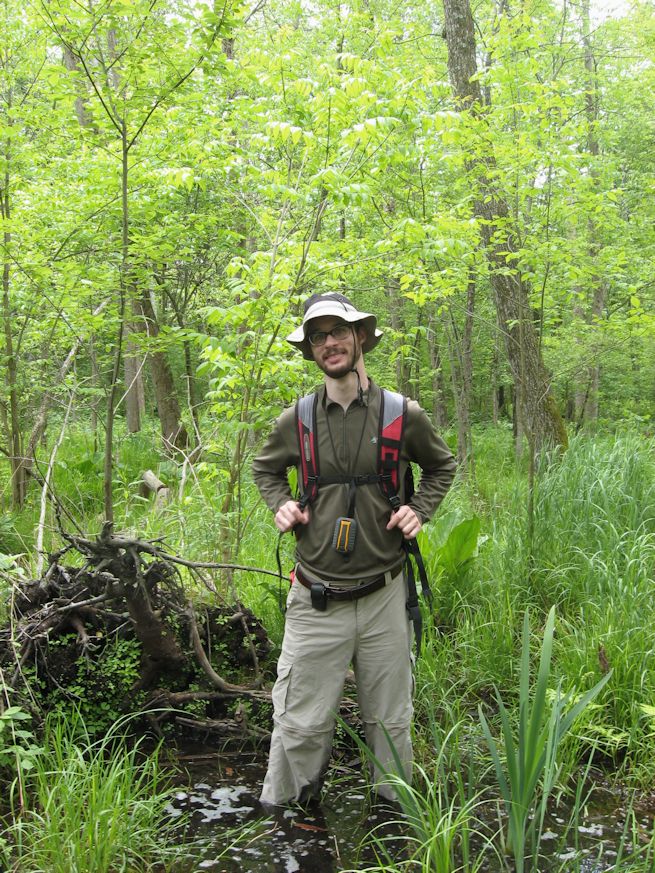Todd D. Johnson, Ph.D. student 
***I will be at the Entomological Society of America Meeting in Minneapolis, MN this 15-18 Nov. 2015.***
***I will giving a talk at this meeting: " Responses of parasitoid wasps to pheromones of cerambycid beetles" on Monday 10:24 - 10:36 am in room 200F***
About Me
I was born in Saratoga Springs, NY. I received my B.S. in Biology in 2009 from Moravian College in Bethlehem, PA. In 2010, I accepted a position to setup and coordinate research releases of three parasitoids of the emerald ash borer in Wisconsin. This project led into my M.S. in Entomology which I completed in the summer of 2013, at the University of Wisconsin-Madison with Kenneth Raffa. Currently, I am a Ph.D. student studying natural enemies of cerambycids with Larry Hanks at the University of Illinois Urbana-Champaign.
Research Interests
I am broadly interested in how insects use and integrate information from their environments to make decisions. Additionally, I am interested in how physiology can modify the strength of responses by insects to external cues. I am specifically interested in host-location and host-range. I wish to use the results of my research to inform management of non-native insects or pests.
Current research projects
Natural enemies of cerambycid beetlesThe advent of increased global trade has also increased the rate of introduction of non-native species of woodboring insects (Aukema et al. 2011). These insects are often very destructive (e.g. emerald ash borer, eucalyptus longhorned beetle) because they escape their native complement of natural enemies, as well as have no coevolutionary relationship with hosts in their introduced range. Biological control has often been used as a management tool to control these pests. In California, the eucalyptus longhorned beetle was controlled by introducing an egg parasitoid from its natural range (Hanks et al. 1996). More recently in Michigan, reductions in the growth rate of populations of emerald ash borer have been attributed to parasitoid introductions (Duan et al. 2015). Thus, biological control projects can often provide strong evidence for the role of natural enemies in regulating populations of insects (e.g. Hairston et al. 1960).
In natural forests it is often difficult to assess which parasitoids and predators are important in regulating populations of native woodboring insects. This can be attributed to the complexity of the communities feeding inside and on the exterior of trees, as well as difficulties of working with insects that are cryptic, with potentially multi-voltine, and difficult to identify as immatures. Subsequently, we know little about the top-down pressures that woodborers experience during their lifetimes.
Many species of parasitoids and predators have been shown to use the pheromones of Coleoptera as kairomones to locate a host. I have been using traps baited with known pheromones of beetles in the family Cerambycidae to identify natural enemies attracted to these compounds. I have hypothesized that different natural enemies will be attracted to pheromones of their host species and that attraction can be used to predict host-relationships.
This is an ongoing research project with two goals:
1. Identify natural enemies associated with different species of Cerambycidae, as well as and their spatial and temporal variation
2. Describe the life histories and behaviors of these natural enemies
Host-choice in cerambycid beetles (with Joseph Wong)
Many species of cerambycids are polyphagous. We know little about their host preferences and how choice of host influences their development and susceptibility to natural enemies
This is an ongoing research project with the goals of:
1. Describing host-preferences for cerambycids
2. Quantifying time to emergence from different hosts
3. Investigating susceptibility to mortality by natural enemies
Contact information
Todd D. Johnson
tdjohns2@illinois.edu
420C Morrill Hall
505 S. Goodwin Avenue
Urbana, IL 61801
Office phone: 217-333-7783
Google scholar / Research gate
CV - last updated October 2015
